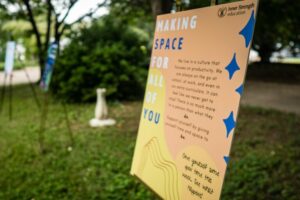For the next few weeks, we will be talking with a few of our instructors about various aspects of teaching mindfulness. As more and more youth are exposed to mindfulness and begin to experience and practice the tools, we wanted to share some of our instructor’s thoughts. This week’s question delves into the process and perceptions of teaching mindfulness.
What is one insight you’ve been having this year about teaching mindfulness to students?
Lina Blanchet: Teaching mindfulness is a process of continual learning for the teacher as much as for the student. We constantly nurture our own sensitivity so we are more responsive to the needs of the students in front of us. We always work with the specific class and individuals we are teaching — being attentive to the students, their needs, and level of understanding. Approaching students with this flexibility also demonstrates to them what it is to respond authentically in the moment, to be creative and not rigid. That teaches students to be open to differences.
Julie Coopersmith: High school students often think mindfulness is the same as other classes they have (ie. math, science, history etc.). They often expect what they are learning from Inner Strength to be linear and have a definitive answer, or starting and ending point. Mindfulness, however, is non-linear. That’s an unfamiliar feeling for students but they like it. Each element, each tool, supports and enhances each of the others. When students start to see that their wellbeing is not one thing, but a whole system that interrelates they start to understand that the actions they take to encourage themselves, calm themselves, explore how thought, feeling and physical sensations all interrelate, they strengthen their confidence and their wellbeing.
We also want people to know how practical mindfulness is. You don’t need to wait in line at the doctor’s office to have access to it. If you learn it, you can do it wherever you are. It’s accessible and it’s private, It can really help to give students a better operating system for life.
Lisa Laney: Due to COVID-19 there is so much restriction on the students’ ability to interact with one another which really affects them physically, mentally and emotionally. As instructors, we prioritize being a warm and positive influence in the classroom. When the students observe that, and feel that their teachers care and are offering tools to support them, and it helps them relax a little and feel more supported during this difficult time.
Next week: What are some of the most surprising challenges that students are facing?



